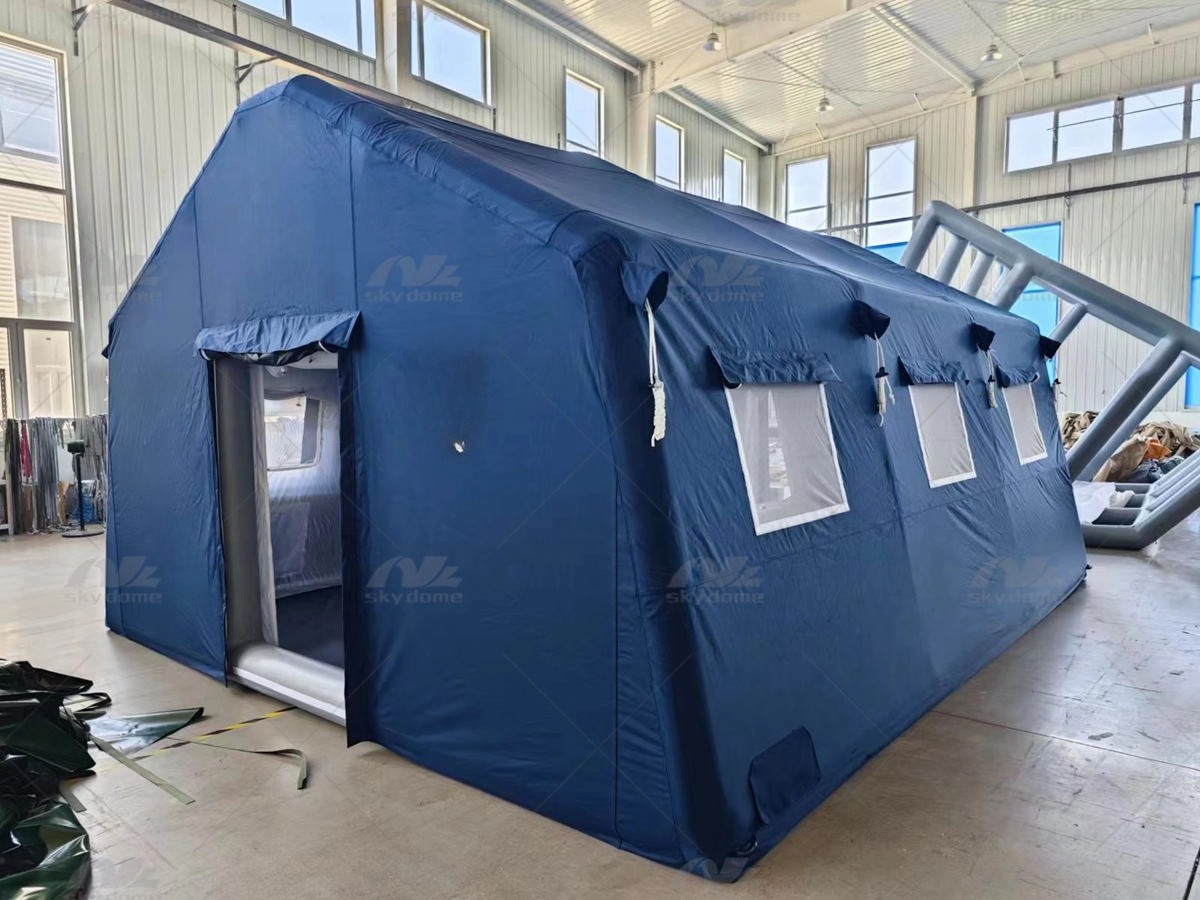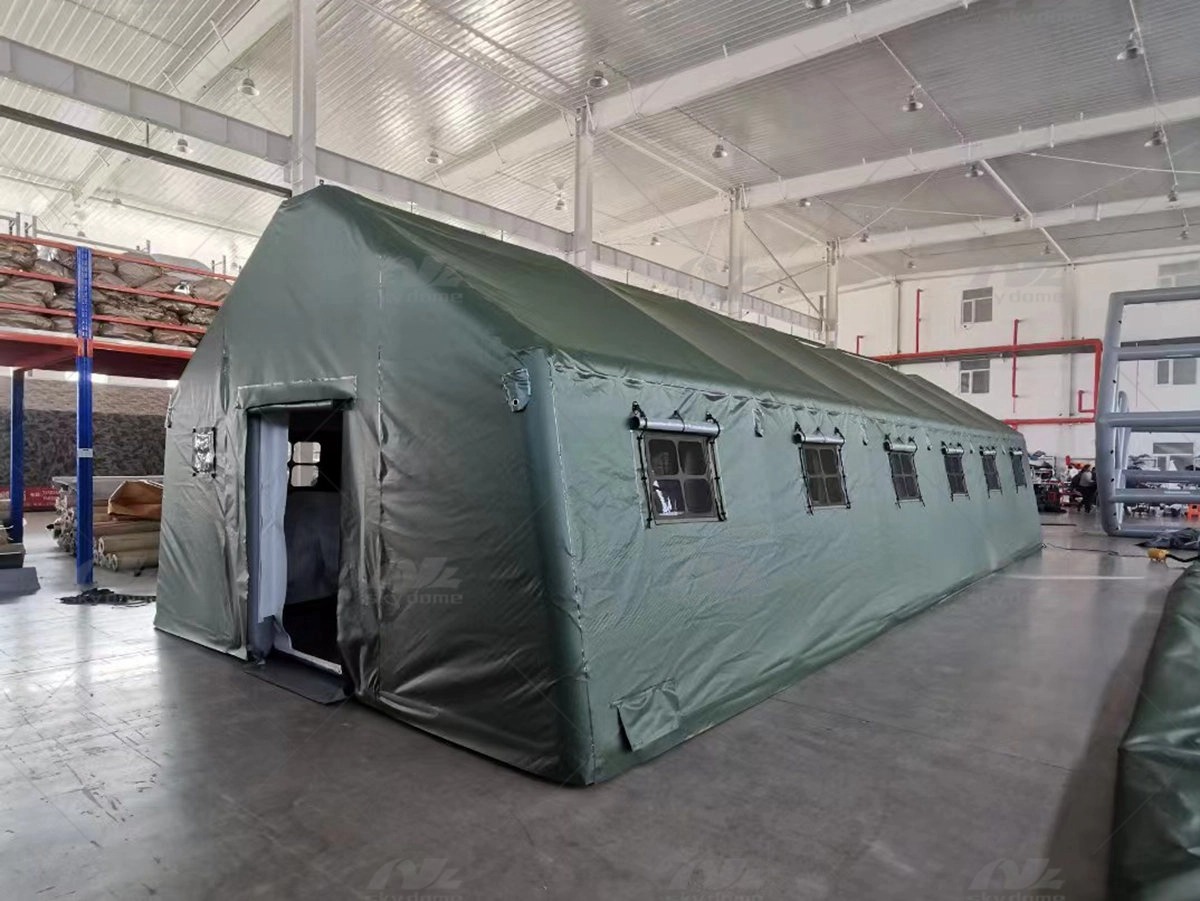
Introduction
In recent years, inflatable tents have carved out a significant niche in the outdoor gear industry. Unlike traditional tents that rely on metal or fiberglass poles for structural integrity, inflatable tents utilize air-filled beams—often referred to as air membranes—to support the shelter. Their growing popularity in both casual camping and temporary outdoor activities stems from their ease of setup, modern design, and versatility. However, a key question continues to surface among outdoor enthusiasts and survival experts: Are inflatable tents more wind-resistant than traditional tents?
This article examines this very question through detailed comparisons, analysis of structural mechanics, and practical applications. We will also explore variations such as the air membrane inflatable tent, outdoor inflatable tent, and inflatable camping tent, focusing on their wind performance and overall utility.
Structural Differences Between Inflatable and Traditional Tents
The Pole vs. Air Beam Debate
At the heart of this comparison lies the structural core: poles vs. air beams. Traditional tents use rigid poles—typically made of aluminum, fiberglass, or carbon fiber—which can snap, bend, or detach in high winds. In contrast, inflatable tents feature flexible air membrane structures that can absorb and disperse wind forces more evenly.
The air membrane inflatable tent is especially noteworthy. Its flexible structure compresses and moves with the wind instead of resisting it, reducing the risk of collapse. The tension created by internal air pressure helps maintain structural integrity even under harsh conditions, a feature rarely seen in pole-supported models.
Furthermore, the seamless integration of the air beam into the tent body minimizes weak points—there are fewer joints and no moving connectors that can fail under stress. This enhanced continuity contributes to better wind resilience.
Wind Resistance Test – Data Comparison
To better illustrate the advantages of inflatable tents in high-wind scenarios, consider the following comparison based on simulated wind tunnel testing and field reports:
| Tent Type | Maximum Wind Resistance | Collapse Points | Structural Recovery | Setup Stability |
| Traditional Tent (Pole) | 40-50 km/h | At pole joints or corners | Poor once collapsed | Medium |
| Inflatable Camping Tent | 60-75 km/h | Rare (air pressure adjusts) | Self-restoring | High |
| Air Membrane Inflatable Tent | 70-90 km/h | Extremely rare | Excellent | Very High |
The chart demonstrates that inflatable tents, especially air membrane inflatable tents, can withstand wind speeds that would typically destabilize or destroy traditional tents. They do not suffer from rigid fracture points and often bounce back into shape after a gust.

Practical Advantages in Temporary Outdoor Activities
Ideal for Emergency and Remote Deployments
For temporary outdoor activities—such as disaster relief operations, temporary work shelters, or mobile medical units—wind stability is non-negotiable. Inflatable tents provide not only rapid deployment but also a more secure shelter against unpredictable weather.
The inflatable tent for temporary outdoor activities also requires fewer accessories for setup. This reduces the number of ground pegs or guy ropes needed, which often fail in high winds. Their quick inflation mechanism makes them ideal for situations where time and reliability are critical.
Moreover, modern designs often incorporate aerodynamic shapes, minimizing flat surfaces that catch the wind and distributing pressure more evenly across the structure.
Common Misconceptions About Inflatable Tents
Despite their advantages, inflatable tents are often misunderstood:
"A puncture will ruin the whole tent": Not true. Most modern inflatable tents feature multiple air chambers, meaning a single puncture won’t compromise the entire structure.
"They can’t be used in cold weather": In fact, inflatable tents can be better insulated, as air beams don't conduct cold like metal poles.
"They’re hard to repair": Most come with easy patch kits and self-sealing valves, making them simple to maintain.
Such misconceptions can deter potential users from adopting this superior technology. However, real-world usage consistently validates their performance, especially under windy conditions.
Maintenance and Durability in Harsh Conditions
Air Pressure Management and Material Resilience
One of the critical factors in wind resistance is air pressure management. Inflatable tents are often built with high-tensile fabrics like thermoplastic polyurethane (TPU) or polyester Oxford cloth, both of which provide exceptional flexibility and tear resistance. These materials help absorb kinetic energy from the wind without rupturing.
Routine maintenance includes:
Checking valve integrity before setup
Inspecting air chambers for slow leaks
Using the provided manual or electric pump to maintain ideal pressure
Compared to traditional tents, which often require spare poles and complex repairs, inflatable tents offer a simpler, more resilient long-term solution—particularly in wind-prone environments.

FAQs – Answering Your Top Questions
Q1: Can inflatable tents handle strong wind gusts?
Yes. Many models are tested against gusts over 70 km/h and demonstrate impressive durability due to their flexible structures.
Q2: Are inflatable tents safe for mountain or coastal regions?
Absolutely. In fact, their flexibility and low-profile designs often outperform rigid tents in such environments.
Q3: Do inflatable tents require more setup time?
No. Most can be fully inflated in 5–10 minutes, significantly faster than pole tents, especially in harsh weather.
Q4: What if the inflatable tent gets punctured?
Modern inflatable tents feature multi-chambered designs, and repair kits are easy to use. A puncture usually affects only one part of the structure.
Conclusion
When it comes to wind resistance, inflatable tents clearly outperform traditional designs in several critical aspects: structural flexibility, material resilience, ease of setup, and reduced failure points. Whether you're planning a camping trip, organizing a temporary outdoor activity, or preparing for an emergency situation, investing in an outdoor inflatable tent may offer not only comfort but also unmatched stability.
The combination of air membrane technology, robust fabric construction, and intuitive design makes these tents a smart and future-proof solution for modern adventurers and professionals alike.


















